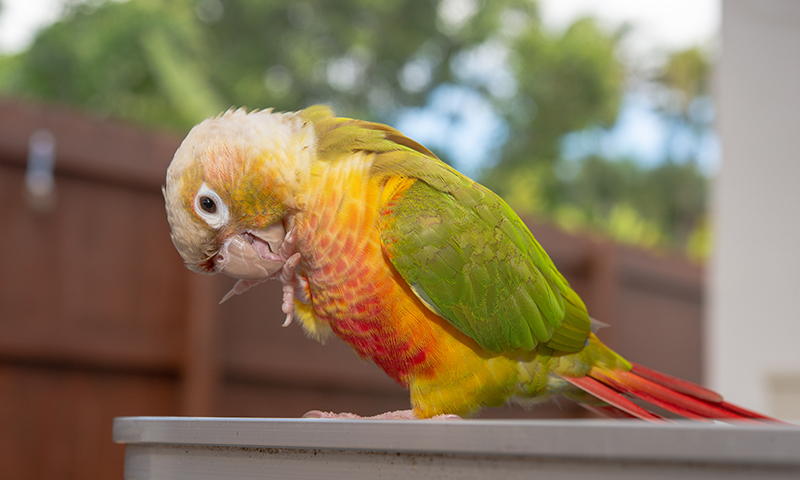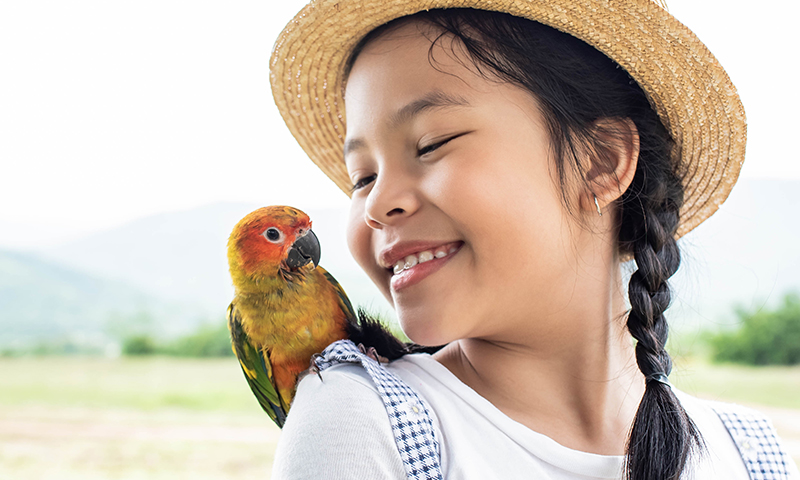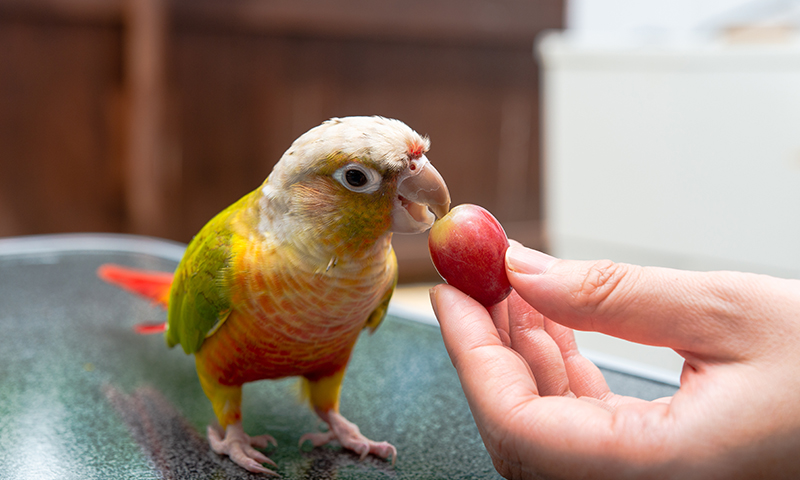Everything You Need to Know About Pet Conures
The playful nature of pet conures appeals to both new and seasoned pet bird owners alike. The small-to-medium-sized parrots show affection, act whimsical, accept cuddles, and initiate socialization.
Some conures even dance!
We learned more about pet conures from bird expert Lily Drabkin. She's the owner of Lily's Avian Care, a traveling pet-sitting service that focuses on in-home avian care for conures, cockatiels, African greys, macaws, and more.
"In many indigenous cultures from their native habitat of Central and South America, the conure is seen as a representation of joy, vitality, and community. It is easy to see why when watching their vibrant feathers hopping to the beat of a pop song," Drabkin shared.

Pineapple Green-cheeked conure
What Colors Are Conures?
Conures come in a rainbow of vivid colors. Most have a main body color of green with a few other colors mixed in, including red, orange, yellow, white, black, and brown.
For example, the most popular species kept as pets include the Sun conure with bright yellow and orange feathers and the appropriately named Green-cheeked conure. Or, you might fall in love with a Mango conure with its orange, yellow, and green feathers.
"Different species of conures have distinct markings, with some resembling a forest in speckled shades of black and green," Drabkin added.
There are over 40 species of Aratinga and Pyrrhura conures, so if you're in the shopping stage, look around until you find the one that looks visually appealing and steals your heart. A few of the most common conures kept as pets include the Jenday, Nanday, Blue-crowned, and Green-cheeked.
How Big Do Pet Conures Get?
Pet conures vary in size based on the species. Juveniles measure about 7 to 9 inches in length. Generally, adults range from 10 to 20 inches long, tail included. Green-cheeked conures usually reach about 10 inches in length. Sun conures get a tad bit larger, at 12 inches long.
When it comes to housing your conure, Drabkin says bigger is always better when picking out an aviary. "As with most companion birds, conures are active and highly social animals that need ample space to move, stretch their wings, and engage with their environment," she educated.
Start with a habitat measuring at least 24" wide x 24" deep and 30" tall with bar spacing 1/2" to 3/4". Then fill it with perches for comfort and parrot toys for mental enrichment. (More on this soon!)
She also says conure parents should consider setting up a bird playground or play gym. This area offers a perch outside the aviary that's easily moved around your home so your pet can engage with you while you do other things, like watching television or working at a desk. This offers both mental stimulation for your pet and more moments of connection for the two of you.

Girl smiling at the conure perched on her shoulder.
How Can I Bond With My Conure?
Drabkin said the naturally social nature of conures makes them easier to bond with than other types of companion bird species. Your relationship with your pet will deepen with "positive interaction and intentional care."
When you initially bring your pet home, he may become suspicious and try to bite. Avoid sudden movements and let the bird familiarize himself with his new home.
She suggests offering stability and consistency by establishing a routine your bird can follow. This might look like uncovering (morning)/covering (evening) the aviary with a light blanket at the same times each day (helping to provide a cozy, sleeping space), spending time talking with your bird each morning, or opening the door to the habitat for playtime each afternoon. If your pet spends time outside of the aviary, close all windows and doors, ensure ceiling fans are turned off, and remove any other pets from the room that may not play well with your bird.
"For a bird that's not physically affectionate, you can sit near the cage and speak softly to the bird so they know you are not a threat and become comfortable in your presence. After a period of this, you can begin to offer treats from your hand," Drabkin explained. "This powerful trust-building tool can teach your bird that your hands are safe."
Drabkin explained that a conure can live 20 to 30 years in captivity, so making the choice to become a bird parent shouldn't happen on a whim. It's a long-term commitment. Introduce your conure to a younger family member or friend so they have lasting bonds with several people in your circle.
What Sounds Do Conures Make?
Conures love to vocalize with chirps, squawks, chatters, and screeches. Unlike some other parrots, conures don't often say words and phrases.
Conures tend to speak up in response to environmental triggers. For example, they may make a specific noise when they see the mailman near the door or when the microwave beeps.
"A conure owner will learn to distinguish their sounds, their soft singing and chattering when they're relaxed, versus their sharp and intense screeches when they're alarmed," Drabkin shared. "Overall, they are social and expressive birds."
She says if you have a misbehaving bird, scan your environment and think of changes you can implement. Something as simple as moving the bird's aviary away from a loud television can have a positive effect on your bird's mood. Or, your pet may feel bored. Offer some playtime and see if your pet shifts into a happy mood.
Do Conures Like Toys?
Conures not only love toys, they need them to provide beneficial mental stimulation and physical exercise. Toys also fuel a conure's natural curiosity, activeness, and intelligent personality.
"Toys can offer birds a chance to engage in their instinctual behaviors of chewing, climbing, foraging, and problem-solving," Drabkin explained.
And when they don't have these things, conures may exhibit unpredictable stress-fueled behaviors, including biting their owners, feather plucking, or screaming.
"The best way to avoid that is to give your bird everything they need intellectually. Birds need to shred, explore, and play just as much as a dog needs to be walked," Drabkin continued. "For conures specifically, I recommend foraging toys and climbing or swinging toys. These enhance their foot dexterity and involve mental planning. Remember to swap out toys periodically for a change of environment."

Conure eating a red grape.
What Do I Feed My Conure?
The best diet for a conure mimics what they would enjoy in their native habitats of Central and South America. A varied daily diet of mainly pellets with additional seeds, fruits, fresh water, and vegetables works best. Drabkin says an all-seed diet doesn't provide the full nutrition your pet needs.
Offer 75 to 80% pelleted parrot food as your conure's main source of nutrition.
Consider trying one of these options:
-
Kaytee NutriSoft Parrot & Conure Food: The soft texture of these pellets features natural fruit flavors to mimic the fresh produce conures would find in the wild. This food comes packed with essential nutrients to support digestive, brain, heart, skin, and feather health.
-
Kaytee Exact Rainbow Parrot & Conure Food: This extruded, crunchy nugget food contains no seeds or seed hulls, so there's less mess or waste. Each pellet offers Omega 3s for brain and heart health, as well as prebiotics and probiotics for digestive wellness.
-
Kaytee FortiDiet Pro Health Conure & Lovebird Food: Developed by an avian nutritional expert to include Omega 3s to support brain and heart health and is rich in natural antioxidants to support a healthy lifestyle and immune function. This blend is designed to maintain skin and feather health for vibrant, healthy plumage.
-
Kaytee Fiesta Conure Food: Formulated by a pet bird nutritionist, this blend of dried fruits, vegetables, seeds, grains, and pellet food offers both mental enrichment, thanks to the varied shapes and textures, as well as balanced nutrition for your conure.
Washed, chopped, uncooked, and unseasoned vegetables (including leafy greens) should make up approximately 20 to 40% of your conure's daily food intake. Then add about 10% of fresh, washed, bite-size cut fruits.
Keep fresh produce on hand for your birdy buddy, such as:
-
Apples
-
Beets
-
Broccoli
-
Brussels sprouts
-
Cucumber
-
Green carrot tops
-
Mango
-
Raspberries
-
Spinach
-
Strawberries
Note: Never offer avocado or onions to your pet conure. These items are potentially toxic to parrots.
"An important note here is that human saliva is dangerous to parrots, so while you may share your food with your birdy, please give them a separate dish and do not share your fork," she added. (And, don't share bites of food you've bitten off.)
Finally, treats are on the menu!
Drabkin said seed clusters, unsalted nuts, and dried fruits are favored by conures. She says seed sticks offer a foraging experience since the bird has to work to loosen and eat the seeds.
Try these treats with your pet:
-
Kaytee Avian Blueberry Superfood Treat Stick: Simply hang this treat stick on the side of your pet's aviary. Let him work to remove the dried blueberries, oat groats, and seeds.
-
Kaytee Bonding Bits: As you work on training your pet to go to a perch or whistle back to you, use these crunchy little morsels with peanut butter flavor coating to reward your bird for a job well done.
-
Kaytee Yo Dips Strawberry Banana Flavored Treats: For the fruit-loving bird, offer up some of these crunchy nuggets with strawberry-banana flavored yogurt coating.
Enjoying Your Pet Conure
These sociable, small-to-medium-sized parrots make fabulous pets when you give them the attention they need and desire. Create a daily routine for feeding, playing, training, and socializing to fully bond with your pet.
Learn more in General Care for Pet Birds and Pet Birds' Eating Behaviors and How To Identify Them.
